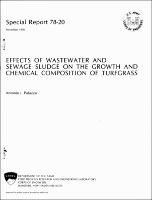Please use this identifier to cite or link to this item:
https://hdl.handle.net/11681/11735| Title: | Effects of wastewater and sewage sludge on the growth and chemical composition of turfgrass |
| Authors: | Palazzo, A. J. (Antonio J.) |
| Keywords: | Growth (general) Heavy metals Sewage sludge Turfgrasses Grasses Vegetation Wastewater treatment Soils Fertilizer |
| Publisher: | Cold Regions Research and Engineering Laboratory (U.S.) Engineer Research and Development Center (U.S.) |
| Series/Report no.: | Special report (Cold Regions Research and Engineering Laboratory (U.S.)) ; 78-20. |
| Description: | Special Report Abstract: A greenhouse study was conducted to determine the effects of wastewater and sewage applications on the growth and chemical composition of two turfgrass mixtures. A mixture of tall fescue (Festuca arundinacea Scheb var. 'K-31 ') and annual ryegrass (Lolium multiflorum Lam.) was compared to a mixture of Kentucky bluegrass (Poa pratensis L. var. 'Merion'), red fescue (Festuca rubra L. var. 'Pennlawn') and annual ryegrass. The mixtures were grown in pots of Charlton silt loam in a greenhouse. Prior to seeding, soil in some pots was amended with sludge at rates of 45 or 90 g/pot. Commerical fertilizer supplying N, P, and K was incorporated with soil in pots designated as controls. Treated municipal wastewater was applied on unamended and sludge-amended soil at rates of 5 or 10 cm per week. Wastewater and sludge treatments increased yields, and total uptake of N, P, K, Zn, Cd, P, Cu, and Ni by the turfgrasses differed by treatment. The two grass mixtures were similar with regard to yields and composition. Larger yields corresponded to greater plant uptake of N, P, K, and metals. Similar removal rates were noted for N and K, suggesting that turfgrasses removing high amounts of N require high amounts of K. Plant concentrations of N, P, K and metals in all treatments were neither deficient nor toxic to plant growth, indicating the suitability of these materials in fulfilling the nutritional requirements of plants. Nitrogen concentrations were similar for all treatments. Phosphorus concentrations were highest in plants subjected to treatments that included sludge additions. Plant concentrations of Zn and Cd were highest in treatments that received wastewater. The highest turfgrass yields for successive clippings were obtained from the control, followed by the 10-cm/wk wastewater and 90-g/pot sludge treatment. During the latter stages of the study, yields were similar, with the exception of the lower yields from pots that received sludge but not wastewater. |
| Rights: | Approved for public release; distribution is unlimited. |
| URI: | http://hdl.handle.net/11681/11735 |
| Appears in Collections: | Special Report |
Files in This Item:
| File | Description | Size | Format | |
|---|---|---|---|---|
| SR-78-20.pdf | 7.35 MB | Adobe PDF |  View/Open |